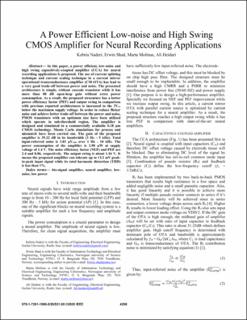| dc.contributor.author | Naderi, Kebria | |
| dc.contributor.author | Habibzadeh Tonekabony Shad, Erwin | |
| dc.contributor.author | Molinas Cabrera, Maria Marta | |
| dc.contributor.author | Heidari, Ali | |
| dc.date.accessioned | 2021-02-25T11:55:46Z | |
| dc.date.available | 2021-02-25T11:55:46Z | |
| dc.date.created | 2020-11-24T11:24:27Z | |
| dc.date.issued | 2020 | |
| dc.identifier.citation | IEEE Engineering in Medicine and Biology Society. Conference Proceedings. 2020, 2020- 4298-4301. | en_US |
| dc.identifier.issn | 1557-170X | |
| dc.identifier.uri | https://hdl.handle.net/11250/2730393 | |
| dc.description.abstract | In this paper, a power efficient, low-noise and high swing capacitively-coupled amplifier (CCA) for neural recording applications is proposed. The use of current splitting technique and current scaling technique in a current mirror operational transconductance amplifier (CM-OTA) has lead to a very good trade-off between power and noise. The presented architecture is simple, without cascode transistor while it has more than 80 dB open-loop gain without extra power consumption. As a result, the proposed structure has a better power efficiency factor (PEF) and output swing in comparison with previous reported architectures is increased to the 2Vov below the maximum supply voltage. In order to reduce flicker noise and achieve better trade-off between the power and noise, PMOS transistors with an optimum size have been utilized which operate in sub-threshold region. The amplifier is designed and simulated in a commercially available 0.18 μm CMOS technology. Monte Carlo simulations for process and mismatch have been carried out. The gain of the proposed amplifier is 39.22 dB in its bandwidth (3 Hz - 5 kHz). Total input-referred noise is 3.03 μVrms over 1 Hz - 10 kHz. The power consumption of the amplifier is 2.98 μW at supply voltage of 1.4 V. The noise efficiency factor (NEF) and PEF are 2.4 and 8.06, respectively. The output swing is about 1.16 V. It means the proposed amplifier can tolerate up to 13.2 mV peak-to-peak input signal while its total harmonic distortion (THD) is less than 1%. | en_US |
| dc.language.iso | eng | en_US |
| dc.publisher | Institute of Electrical and Electronics Engineers (IEEE) | en_US |
| dc.rights | Navngivelse 4.0 Internasjonal | * |
| dc.rights.uri | http://creativecommons.org/licenses/by/4.0/deed.no | * |
| dc.title | A Power Efficient Low-noise and High Swing CMOS Amplifier for Neural Recording Applications | en_US |
| dc.type | Peer reviewed | en_US |
| dc.type | Journal article | en_US |
| dc.description.version | publishedVersion | en_US |
| dc.source.pagenumber | 4298-4301 | en_US |
| dc.source.volume | 2020- | en_US |
| dc.source.journal | IEEE Engineering in Medicine and Biology Society. Conference Proceedings | en_US |
| dc.identifier.doi | 10.1109/EMBC44109.2020.9175842 | |
| dc.identifier.cristin | 1851520 | |
| dc.description.localcode | Open Access This article is licensed under a Creative Commons Attribution 4.0 International License, which permits use, sharing, adaptation, distribution and reproduction in any medium or format, as long as you give appropriate credit to the original author(s) and the source, provide a link to the Creative Commons licence, and indicate if changes were made. The images or other third party material in this article are included in the article's Creative Commons licence, unless indicated otherwise in a credit line to the material. If material is not included in the article's Creative Commons licence and your intended use is not permitted by statutory regulation or exceeds the permitted use, you will need to obtain permission directly from the copyright holder. To view a copy of this licence, visit http://creativecommons.org/licenses/by/4.0/. | en_US |
| cristin.ispublished | true | |
| cristin.fulltext | original | |
| cristin.qualitycode | 1 | |

